Connecting the Past, Present, and Future
Evolution does not stop: Causal relationships between our behavior, our well-being, our social and natural environment, and our cultural institutions and technologies have shaped us as a species, shape our present, and will continue to shape our future. These relationships are complex, extending over larger dimensions of space and time than our minds can intuitively handle. Because of this, our behaviors and the worlds we create often have outcomes we did not foresee or intend.
On the positive side, today, thanks to the work of many scientific disciplines, we know a lot about these causal relationships. We can understand the impact our behaviors and technologies have on our well-being and our environment in ways that might help make the world a better place.
What progress is there? Where are the biggest challenges, the biggest opportunities, the biggest strengths and weaknesses? In which of these factors do we, as individuals and as communities, have the opportunity to consciously intervene to steer the world in a direction that we all want?
Causal relationships in social-ecological systems
The development of our global social-ecological system is characterized by feedback loops that arise from the interplay between environmental conditions, our technologies and institutions, the behavior of individuals, and the relationships between individuals.
Many of the changes in the world today are the result of positive feedback. Some of the outcomes they produce we deem to be “good” – they are helpful for achieving our common goals. Other outcomes they produce we deem “bad” – they present challenges in achieving our common goals.
Image source: UN Department of Public Information (Guidelines)
Which sustainable development goals are most important to humans in the world? Which goals are most important to you?
In a global online survey of the United Nations people can submit their opinions.
- Take part in the survey and explore results here: https://myworld2030.org/?lang=en
Classroom ideas:
Students in the class submit their anonymous responses, and the whole class analyses the results (counting up the number of votes for each goal).
Afterwards, the results of the class are compared with the global results, or with the results of your own country or other subgroups. What similarities and differences are there? Why could the results of this survey be different between different groups of humans?
What do the results of this survey tell us about the challenges and opportunities for addressing global sustainability issues (e.g. climate change)?
How do our social and natural environments, our behavior, our technologies and institutions, our perception affect each other?
Causal diagrams allow teachers and students to reflect on concrete relationships between these factors in particular contexts, and to discuss ways in which we can consciously influence the evolution of these factors, individually and as a community.
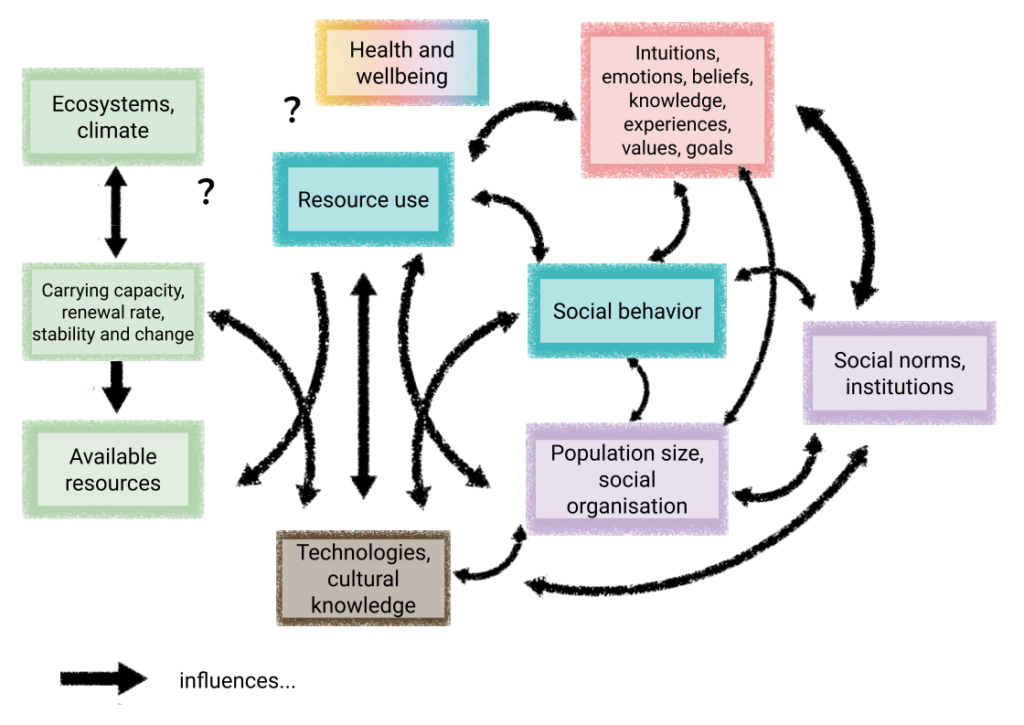
Global trends and relationships of the recent past, present, and future
Classroom idea: Jigsaw
Students form core groups of 5-6. The task of the group is to create an informative poster on the causal relationships between human social behavior and cognition, technologies, population size and social organization, social institutions, resource consumption, and environmental impacts.
Each student in a group becomes an expert in a subset of all the causal relationships (possibly the groups may be encouraged to organize themselves and decide who should become an expert on which topic). Each expert initially deals independently with their topic, i.e. a group of interrelationships as listed below.
The experts form expert groups. The task of the group of experts is to understand their part of the causal relationships between factors in order to explain it to the classmates in their core group. With Internet access, students can also search the Internet for more information on the topics and their interactions. Through discussion, all members of an expert group compare and synthesize their understanding of certain concepts and the whole topic.
The experts return to their core group and each one presents the findings about their special topic. All others listen attentively to the expert and can ask questions. Connections between the different factors and topics are identified. Finally, the group brings together all the findings of the experts in a causal map and creates an informative poster.
Following this group work, or as part of it, students can discuss the following questions:
How could these causal relationships influence the future evolution of our species and our world?
What can and should we do, as individuals and as a community, to steer these causal relationships in a direction that we all want? Which factors can we influence, and if so how?
see also:
Cox, M., Steegen, A., & Elen, J. (2018). Using Causal Diagrams to Foster Systems Thinking in Geography Education. International Journal of Designs for Learning, 9(1), 34–48. https://doi.org/10.14434/ijdl.v9i1.22756
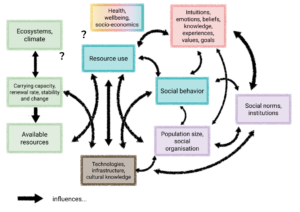
Causal mapping pieces for causal relationships in the present and future
Materials for creating a causal map on the relationships between human behaviors, technologies, institutions, social and natural environments
Relationships between communication, education, and technologies
- Communication: language, writing, printing, internet
- Education
- Technologies
Our evolved abilities for communication, social learning and teaching have enabled cultural evolution: certain technologies and cultural knowledge are accumulating, are being passed on to subsequent generations, and further increase the innovation capacity of our species. Technologies changed the way we communicate and the things and ways we teach and learn. Education and communication increase the diffusion of technologies and knowledge, and in turn lead to new technological and cultural innovations.
What role will education, communication and innovation play in the future of humankind? How can we ensure that all people have access to good education? How can we ensure that our communication and innovation capacity will have positive effects on the sustainable development of our species?
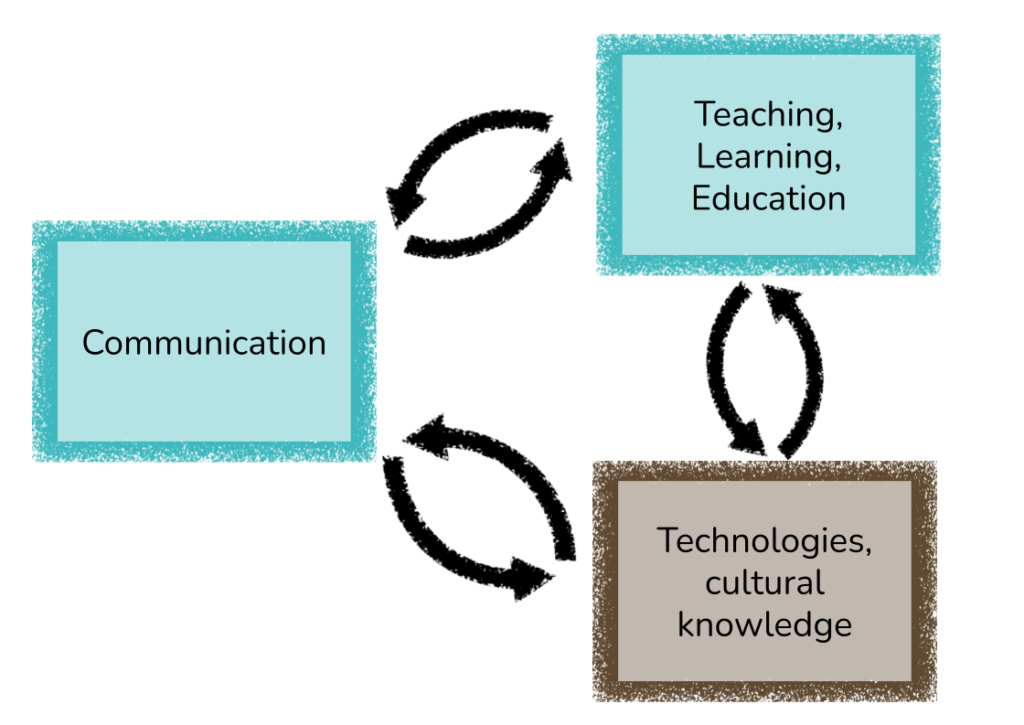
Relationships between social networking and spread of innovations
Our evolved social behavior allows us to connect with many people. Social networking and our ability for social learning (including imitation) enables the diffusion of technologies and cultural knowledge. This increases the innovative ability of our species. In turn, technologies allowed for increasing social networking, which today extends to the global level.
What role will social networking play in the future of humanity? How can we ensure that social networking has primarily positive effects on our well-being and our adaptability as a species?
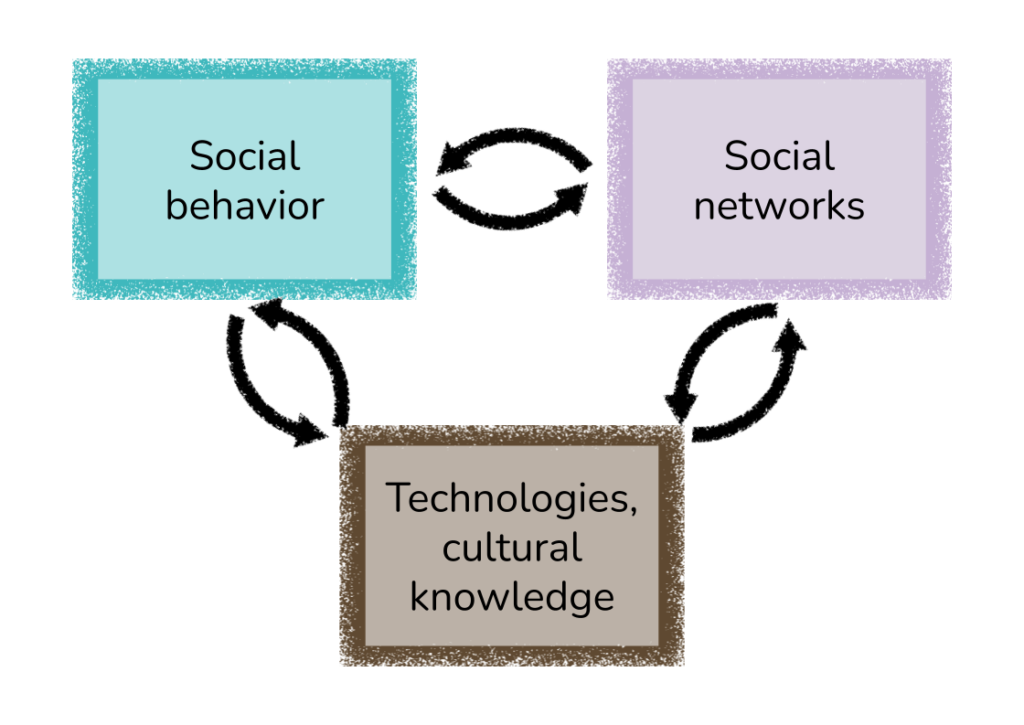
Relationships between food, medicine, life expectancy, and population growth
Our technologies and cultural knowledge have allowed an increasingly efficient food production, medical care, hygiene, and sanitation. This led to an increase in life expectancy and growth of our global population.
What role will technologies and cultural knowledge play in how we eat and live in the future? How can we assure that all people have access to high quality food, medicine and sanitation?
How will the population of our species develop in the future?
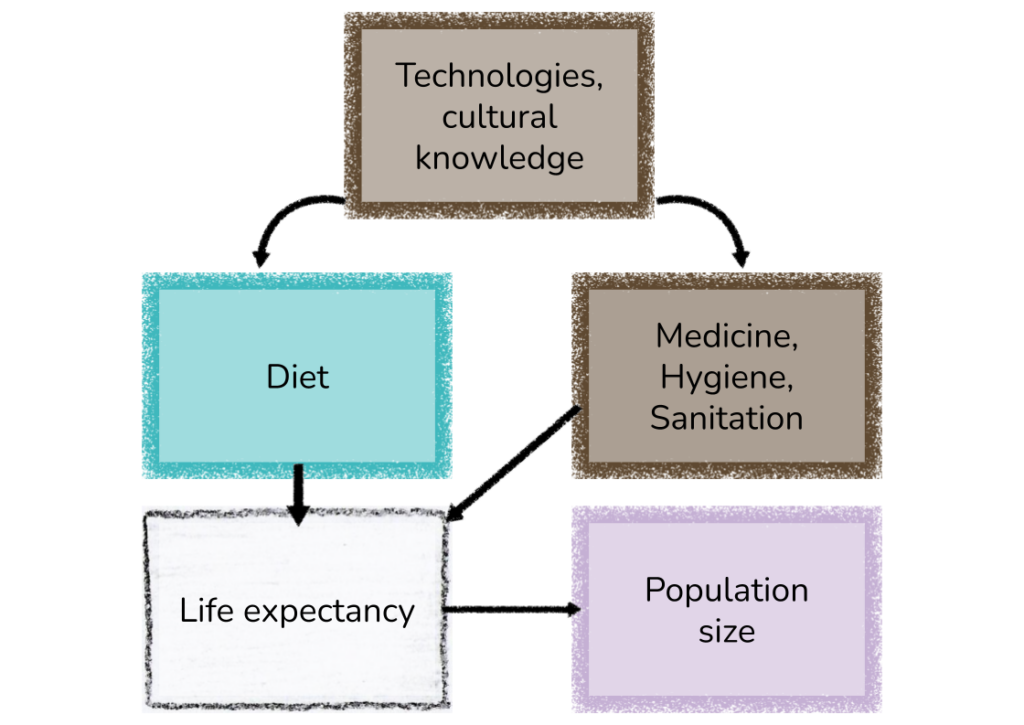
Relationships between institutions and social organization
- Democracy
- Social (in)equality
- Corruption
- Conflict and War
Our increasing group and population sizes meant a dramatic departure from our lives in small egalitarian hunter-gatherer-groups, and new ways of social organization, regulated by evolving social norms and institutions.
Some of these norms and institutions allowed peaceful coexistence and cooperative societies, but many others also lead to increasing social inequality and political instability, with negative effects on human well-being.
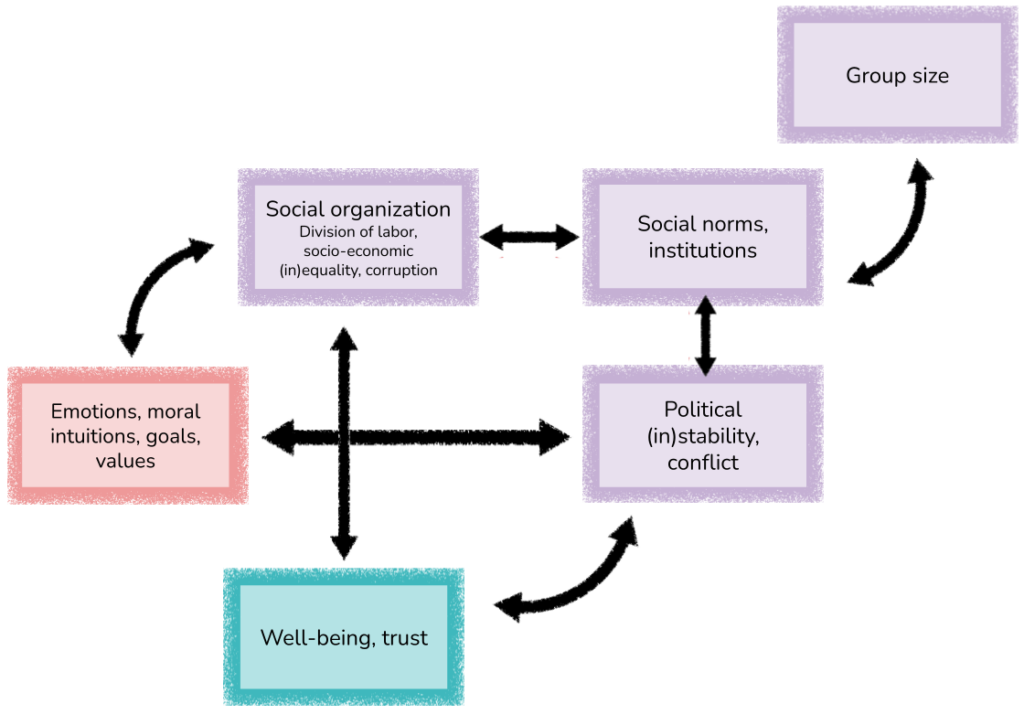
Relationship between technologies, population size, and resource consumption
Our technologies and growing population increase our consumption of resources. The carrying capacity and renewal rate of a resource limits its availability. If our consumption reaches the limits of sustainability, i.e. is higher than the renewal rate, then we need to change something to ensure sustainable resource use and thus availability of resources in the future.
Innovative technologies can increase the carrying capacity and renewal rate of various resources, make resource use more efficient, or enable a shift to other resources (e.g. to resources that have a higher carrying capacity and/or renewal rate).
Also, collectively established rules and regulations, social norms, and changes in our behaviors play important roles in reducing our total consumption of resources.
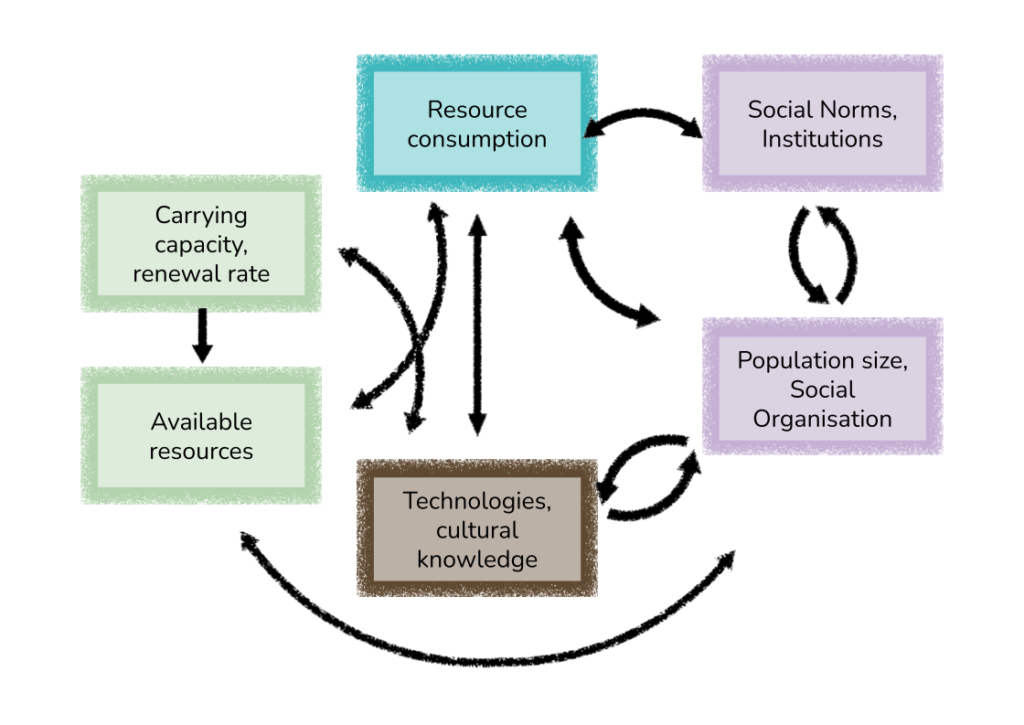
Relationships between resource consumption and the natural environment
Our behavior, our technologies, and our global population size have had more and more severe effects on our environment throughout our history. They change the environmental conditions under which we live, including climate, biodiversity and the resilience of ecosystems. These environmental conditions in turn affect the ability of our species to adapt to future changes and live sustainably.
How can we change the impact of our behaviors and our technologies on the environment so that they do not endanger our own livelihoods, the environment we depend on, and the livelihoods of humans in the future? What role can and should innovative technologies and science, social norms and institutions, media, education, and individual behaviors play?
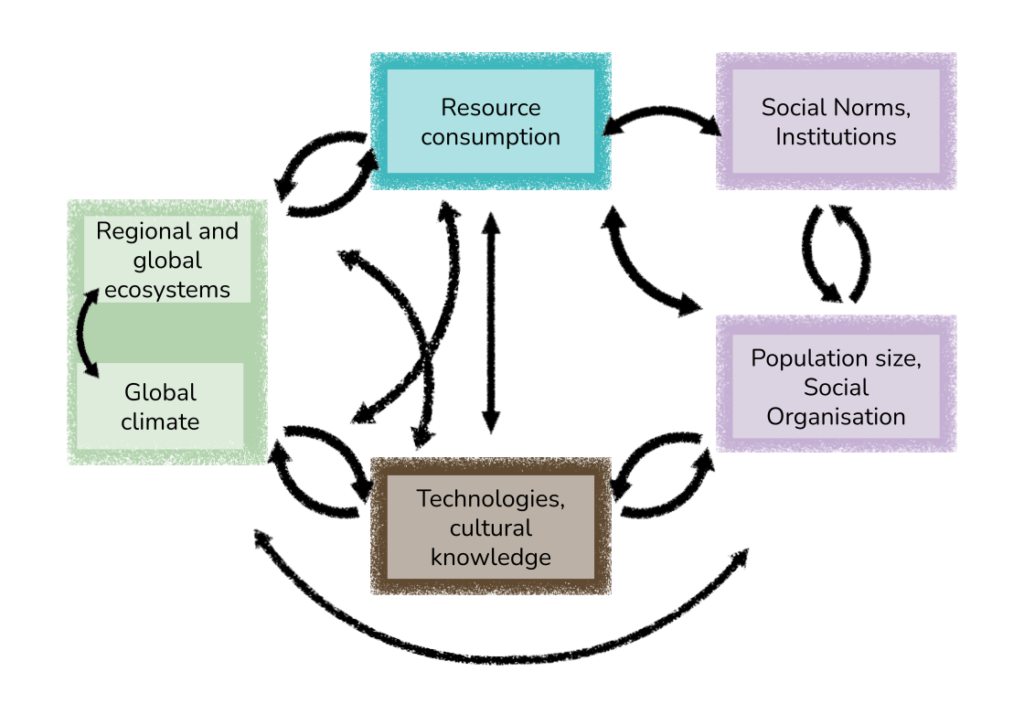
Mismatch?
How will human behaviors and motivations influence the future? Are our evolved human characteristics still well-functioning adaptations, or can they lead to disadvantages for human well-being and the sustainable development of our species under today’s environmental conditions?
How can we change our abiotic, biotic, social, and cultural environments as well as our own behaviors to benefit our long-term well-being and the sustainable development of our species?
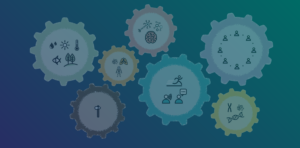
Mismatch
Teaching resources and information for learning about the concept of evolutionary mismatch in human behavior and its potential role in sustainable development

